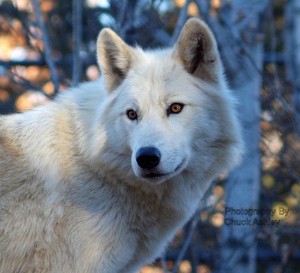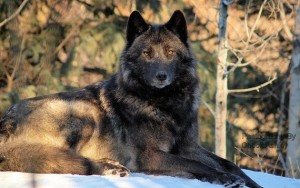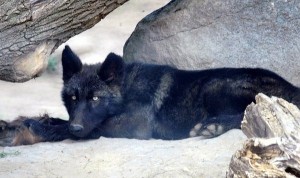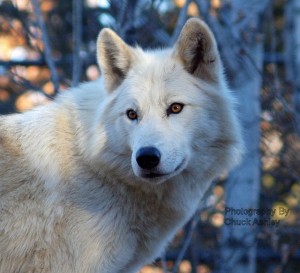One day in August I arrived home to find a baby snake on the basement floor in front of my dog Chase’s kennel. Any snake sets off a visceral reaction that usually makes me scream and jump out of my shoes. Somehow, a snake is always a surprise. It must be a survival instinct for my heart rate to go up and the hair on the back of my neck to stand at attention. But this guy was tiny, not much bigger around than a pen or pencil, and probably less than a foot long. He had rust red and gray and black markings. I think he was a corn snake. He was sitting in front of Chase, and I swear they’d had a conversation.
The snake apparently had the same reaction to me. He seemed to be concerned and very alert, but to my amazement, he didn’t move. I told him to “stay”, a natural thing for me to say since I often tell the dogs to stay. I went back out to the garage and got a shovel and a bucket. When I returned, the snake was still there (apparently an obedience prospect!) and even when I approached him, he stayed put. I gently scooped him into the bucket, took him outside, and released him in the long grass far from the house.
I could see that Chase was relieved. A few years ago, I found a baby snake in the basement and recognized it as the miniature version of a snake that can grow to be about five feet long. By the end of the summer I found 16 of the little guys in the basement and one in the living room (yes, a determined little snake can climb stairs!). We were doing construction on the front porch that year. Apparently the mama snake had been disturbed when about to lay her eggs and had left them in a place that allowed the hatchlings to drop into the basement.
I couldn’t catch these little snakes easily and I was afraid of them. Creatures that I can handle just fine in the wild can really bother me when I find them in my house. I’m not proud to say this now, but I ended up chasing the little guys down and beating them with a broom. I’ve noticed that fear of something different can make people react in extreme ways.
One day, after beating a little snake to death, I noticed Chase cowering in the corner. He was rescued from an abusive situation and must have been at the wrong end of the broom a few times himself. Seeing me wield the broom that way and knowing that I could suddenly turn into a crazy person had traumatized him. He made me realize that it was silly for a grown woman to beat a little snake to death with a broom. My adrenaline and my fear of finding these little snakes everywhere made me overreact.
So this year, when I found the baby snake, I swear that Chase had been coaching the little guy. I can feel Chase saying, “Just hold still and she won’t run you down. If she can catch you, she can set you free.” Seeing Chase right there in front of the snake made me realize that I didn’t want to traumatize him. And since the snake stayed still and was so easy to catch, I was able to gently put him in the bucket and set him free in the grass. I guess Chase was coaching me too! If you pay attention, you can learn a lot from your dog.
Those who are familiar with spirit animals know that a snake appearing as a totem signifies that a transition or spiritual awakening will take place. Snake energy is said to be the energy of wholeness and the ability to experience anything willingly and without resistance. It is the knowledge that all things are equal in creation. It also signals a transition in your life, with new opportunities and changes. That is certainly true for me, with many transitions taking place this fall. I also think that perhaps Chase and the little snake created a spiritual awakening in me, or at least an awareness that I don’t have to react violently to a creature that frightens me. I don’t even have to experience fright.
With the wolf hunt controversy raging across our northern states, I’ve also been thinking a lot about how we might live in better harmony with the wolves in our country. They were removed from the endangered species list earlier this year. Their population in Minnesota has been steady at about 3,000 for the last ten years. In spite of an existing plan to ban hunting wolves for five years after they’re removed from the endangered list, our DNR is already planning to hold a controversial wolf hunting and trapping season beginning on November 3rd. Minnesotans have resoundingly spoken out against hunting and especially trapping wolves, with 79% of those responding to a 2012 DNR survey indicating that they are against a wolf hunt.
Wolf advocates argue that the wolf population is still fragile and that random killing with traps and firearms may destroy wolf pack structures, leaving packs weak, more desperate for food, and even more likely to prey on livestock. Indiscriminate killing of wolves that have not threatened livestock may take healthy alpha wolves and female wolves who are caring for pups, and thus also kill the pups. They state that the 400 wolf limit in Minnesota may be much more damaging to the wolf population than taking out the 400 weakest wolves of the stable population of 3,000. Wolf advocates here think that the hunting/trapping season needs to be stopped before November 3rd, when it may be too late for the health of our wolf population.
Many deer hunters are also against the wolf hunt. They don’t see the morality in killing something you don’t eat just for sport (or a “trophy” pelt), and they think trapping is cruel. Some deer hunters have also defended the wolves because as the wolf population became healthy, chronic wasting disease (CWD) went down in the deer population and the hunters’ risk of being exposed to CWD was lower. The wolves took out the weak and provided a balance. Studies show that wolves are necessary for maintaining balance in the environment. When wolves are gone, other populations grow out of control.
Those who are against trapping wolves think that trapping is cruel. At least a mouse trap is designed to kill instantly. In Minnesota, the traps only have to be checked every 24 hours, so a wolf can be left in a snare or a leg hold trap to endure physical and mental torture for long periods of time. Hunters are required to report the wolves taken. But it’s possible that if more than 400 traps are set, we could lose a lot more than 400 wolves before the traps are even checked and the number of wolves killed is reported to the DNR.
The pending wolf hunt here seems to be set up for “Safari” hunters to bag wolf “trophies”. On taxpayer dollars, Minnesota DNR employees gave a seminar at a Safari hunters club on how to find and trap wolves. Did we really just protect the wolves for almost 40 years so safari hunters can “bag” wolf pelts for their walls? We may be about to reverse the 40 years it took to bring the wolves back.
What about those who are in favor of the hunt? While educating people at the Minnesota State Fair about the pending wolf hunt, I spoke with a number of people from around the state. One guy told me that a wolf killed his dog and his emotional reaction made him say, “Kill them all!”
It’s important to note that different areas of the state have different wolf populations and situations. I learned the most from two hunters from Itasca County in northern Minnesota. At first they didn’t want to talk to me and were antagonistic to my “Stop the Hunt” t-shirt. I asked them if they had a few minutes to tell me what’s going on in their area because I want to learn from people from other parts of the state. When they realized that I was going to listen to them and not argue with them, they had a lot to say. They told me that their area is overrun with wolves and that the deer population is down. Where they used to see deer scat, they now see wolf scat, with deer hair in it. They encounter wolves in the woods and one of them claimed that he has been surrounded by wolves when in a deer stand, and when sitting on the ground below a deer stand. He thinks that the wolves in their area need to be managed. He said that when guys are out in the woods and feel threatened by wolves, poaching occurs. Wolves are being killed without being reported.
As they talked, we found more common ground than I expected. We agreed that farmers and ranchers need the right to protect their livestock (which they already have). Surprisingly, both men agreed that trapping wolves is cruel and shouldn’t be allowed. They don’t want guys from the city setting traps up there. They love wolves and don’t want them to become extinct. Both men agreed that a wolf hunting season should focus on areas that are “overrun” with wolves, that the hunt should be managed more strictly by the DNR, and that firearms and bows are sufficient to manage the wolf population. They said that the DNR doesn’t currently have a good way to manage the wolf hunt, and that poaching will be inevitable, “as it is with deer”, because the hunting is not monitored closely enough. They said that guys who encounter wolves may shoot three wolves and only report the one they have a tag for. I found it interesting that guys who are out in the north woods all the time commented that poaching wolves is common and that trapping is cruel.
In all my conversations with people, most, even deer hunters, objected to “trophy” hunting for wolves. Many deer hunters don’t believe in killing something you can’t eat, unless it’s threatening your livestock, family or property. Most don’t like the idea that our DNR is using taxpayer dollars to give seminars to “safari” hunters to teach them to trap and kill wolves.
Also at the state fair, I talked to a couple from north of St. Paul who raise sheep and have seen wolves, but have had no problems with them. I also spoke with a deer hunter who has seen and heard wolves in his area and thinks they’re beautiful. He hasn’t had any problems with wolves.
I live in the country 20 miles from St. Paul, with a state park in my backyard. To my knowledge, we don’t have wolves here, but we often hear coyotes and have had several encounters with them. One time a coyote ran my dogs and me out of the park. I was scared because the coyote didn’t act like a normal wild animal. It was defending territory within the park (probably had pups) and I was afraid that my older dog would become coyote bait. After yelling and waving large branches and trying to get the coyote to back off, I picked up my old dog, left the trail and ran cross country with my younger dog running beside me as the coyote followed us, too closely for my comfort, and ran us out. We got back to the truck safely and the coyote came almost all the way to the road. If I encountered wolves that were not elusive and were this aggressive, I might feel the need to defend myself and my home from them.
Our dogs descended from wolves, as people and wolves found ways to live that benefitted both species. Our domesticated dogs, although not wild, are genetically very similar to wolves. The bond and relationship between people and dogs grew from the relationship between people and wolves. So, what went wrong? Why do some now want to kill the wolves?
As a war on wolves raged in Washington State, Idaho, and Wyoming, and a hunt was pending in Minnesota, Michigan and other states, wolf advocates were relieved in late August when it was announced that the hunt in Wisconsin may be cancelled this year. The wolf hunt that allowed hunting (tracking) wolves with dogs was legally challenged as being inhumane and something that could result in a gruesome fight that a dog would most likely lose to a wolf or a pack of wolves. I doubt most hunters would want to put their good hunting dogs in the path of wolves.
Farmers, ranchers, and other property owners already have the right to protect their livestock, property, and families from wolves that threaten them. I thought the sentiment on this point was unanimous until I learned of those who graze cattle on public land in Washington State, where wolves are taking out cattle. Many are opposed to killing the wolves that kill cattle because the wolves were there first. Those who graze cattle on the public land knew the wolves lived there when they made the decision to graze their livestock there. So the right to protect livestock can be a gray area too, when the livestock are grazing on public lands where many feel that the priority should be to protect the wildlife.
In response to an online article about the pending Minnesota wolf hunt, one man responded, “I was an avid meat hunter for decades, but do not approve of folks who keep finding excuses to kill wolves, to include blaming them for lack of game rather than their lack of hunting skills. I have no problem with our predators having their share and I am convinced we need them in the natural order to maintain balance.”
A woman from northern Minnesota, responding to the same article, wrote: “Glaring and obvious purpose of the Hunts, going on all over the Country, is for a small group of people. It is not to protect the “livestock” because the methods chosen create will nilly shooting. The “hunters” also know nothing about the way wolves pack, mate or make families and NO consideration has been given to this either. Government and those who are supposed to make healthy decisions, have ignored the majority of the Country that oppose the hunts. So plain and simple, it is because of a small group of people that have given large contributions and put pressure upon politicians in order to attain funds for elections… I have many many years living in areas with wolves in MN and the whole hunt was built upon a lie. It is almost as if the idea of killing a “wolf” is akin to “killing the devil or evil”. Very stupid, ignorant and sinful all the way around.”
So is the wolf merely a villain, or, if we listen, is the wolf a spirit guide? Can people and wolves once again find ways to live that benefit both species? What can we learn from the wolf? The wolf totem signifies intuition, learning, and spirit. The wolf teaches us to learn about our inner self and to find our inner power and strength. To achieve this, we must take risks and face our deepest fears (as I did with the snake). A wolf totem demands sincerity. If we are listening, the wolf reminds us not to waste resources and to learn how to avoid trouble and confrontations.
To wolf, family is everything. Wolf is a hunter, and wolf hunts not for sport or trophies, but for survival, and plays a very important part in the great Creative Order of things by taking out the old ones, the weak ones, keeping the herds strong, and swiftly ending the suffering of those whose time has come to an end. Wolf is absolutely at home in nature, and wolf is strong, intelligent, caring. Wolf hears and sees everything; wolf scents the air and knows the seasons; and wolf raises the voice to fill the night. Wolf is the spirit and totem of leaders, of those who take responsibility for the well being of the younger and weaker ones, who look out for them, protect them, provide for them and fight for them.
Perhaps if we listen to the wolf, we will stop ourselves from “going nuts with the broom” and find a different way, remembering that the bond and relationship between people and dogs grew from the relationship between people and wolves. Do we always need to react extremely and destroy creatures that are different, that maybe we don’t really understand? What will happen to the balance in nature, if we decimate the wolf population again? Can we leave the wolves alone, and find a way to gently and peacefully coexist, as I did when I released the little snake in the long grass outside? Is the war on wolves across this country really necessary, and will we stop it before it’s too late?
I’m working on living peacefully with snakes. I hope we can learn from and make peace with our wolves before it’s too late.
Note: This week the Center for Biological Diversity and Howling for Wolves filed a lawsuit against the Minnesota Department of Natural Resources (DNR) challenging the agency’s failure to provide a formal opportunity for public comment on recently approved rules establishing wolf hunting and trapping. The conservation groups are seeking a preliminary injunction to prevent the opening of hunting and trapping seasons this fall.
Find more information on the pending wolf hunt in Minnesota at: www.HowlingforWolves.org.
Totem information excerpted from:
http://www.linsdomain.com/totems/pages/snake.htm
Posted on September 21st, 2012 Filed under: General, News, Wolves






Leave a Reply
You must be logged in to post a comment.